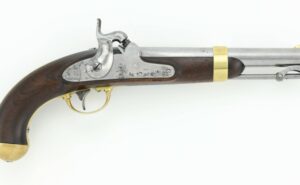Fifty years later, stolen powder horn and firearms returned to New England museums

A close look at the detail engraved into the powder horn that is in the Stone House Museum’s collection in Belchertown, Mass. (Carrie Healy / NEPM)
Until recently, Delaware resident Michael Corbett had dozens of stolen artifacts in his collection of iconic items. Last month, the FBI and other agencies held a ceremony in Philadelphia to give the items back to the museums and historical societies that had lost them.
The stash included a rare 1843 pattern pistol from the Springfield Armory National Historic Site. It was made to show to contractors what the Armory wanted manufacture, like a 3D blueprint.

A pattern pistol at the Springfield Armory National Historic Site. Twelve of them were made, including the one stolen — and now returned. (Submitted / National Park Service)
“They only made 12. This is marked serial No. 12, both on the pistol and in the records, so it was a fairly straightforward identification,” Springfield Armory curator Alex MacKenzie said.
That pistol, which had been missing since June 22, 1971, wouldn’t be the only item from the area taken that day. A rare 1847 Colt Whitneyville Walker revolver was stolen from the Connecticut State Library in Hartford, as well.
Later that summer, the Longmeadow Historical Society lost items, as did Belchertown’s Stone House Museum, whose 1758 powder horn disappeared. It was stolen in August of 1971, according to Thomas Stockton, president of the Belchertown Historical Society.
Stockton said Corbett actually visited here.
“And [he] signed our guest book in 1971 with his, at the time, girlfriend, who later became his wife And then, soon thereafter, the museum was robbed. And of course, back then we didn’t have alarm systems or pictures of things in the way we do now,” Stockton said.
Officials said Corbett pleaded guilty, last August, to possession of stolen items. As part of his plea agreement, he turned over what he had, which included the Stone House Museum’s missing powder horn, once owned by a Belchertown’s Justus Dwight.
“Justus Dwight’s father was one of the original settlers in Belchertown, and Justus Dwight would have been about 19 in 1758 when he inscribed his name on this powder horn,” Stockton said.

Thomas Stockton is the president of the Belchertown Historical Society, which runs the Stone House Museum in Belchertown, Massachusetts. A powder horn, stolen from the museum decades ago, sits on the table in front of him, following its return. (Carrie Healy / NEPM)
“It’s very important to us because when you’re telling the story of historical people, artifacts, a toy, a bit of clothing or something as magnificent as this powder horn — really help to bring people alive and make them real in a way that words on a page can’t,” he said. “Justus Dwight was very important in Belchertown.”
His handwritten diaries, kept at the museum, are some of the only eyewitness accounts of when Massachusetts ratified the U.S. Constitution.
“An he voted ‘nay,’ by the way,” Stockton chuckled.
Stockton said he would assume Dwight used the powder horn himself.

A 1758 engraved powder horn owned and carried by Justus Dwight in the French and Indian War. (Carrie Healy / NEPM)
“His father was a captain in the French and Indian War and that’s when it was signed. And you’ll see the inscription on it. It says Lake George, which was certainly a place where military action was happening,” Stockton said.
In addition to the location, and Dwight’s name, the horn has detailed, intricate drawings carved into it.
“I don’t know if he … had an artistic bent, or just a creativity thing,” Stockton said, noting the horn also has an embedded message. “Right where he put his name, it says, ‘Steal not this horn for fear of shame, for here you find the owner’s name, Justus Dwight.'”
The powder horn could certainly attract fans of folk art, given its carving, Stockton said, as well as firearms collectors.
“The man in whose possession this was, and we believe he’s the one that stole them, he had many articles. Things were returned to 17 museums that he had. And they were all firearms and military-related things from the 18th and 19th century,” he said.
The Justus Dwight powder horn has been reunited with many artifacts of the Dwight family at the Stone House Museum, and will be on view later this spring.

(FBI)
A New England target buggy rifle made in the 1850s was also among the items returned from this trove. Its owner, the Longmeadow Historical Society, has it already back on display.
MacKenzie, from the Springfield Armory National Historic Site, said the returned pattern pistol does not appear to have ever been fired. He said it is in remarkable condition, although it needs some cleaning.
“It certainly has a lot of corrosion on it. A lot of that is internal, interestingly, particularly in those parts where iron portions meet up with the wood portions, which is something that happens quite a bit with mixed material artifacts,” MacKenzie said. “But there is a good amount of corrosion in there that we’ve been working on taking care of, as we prepare this for exhibit. Because we’d like to get it out where people can see it.”
That pistol be on display this summer.
